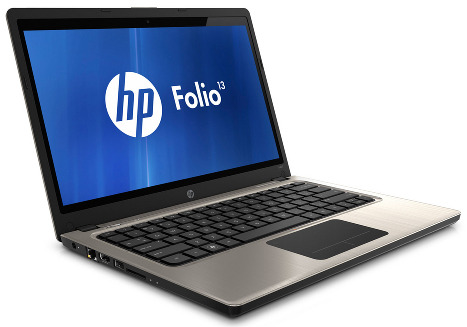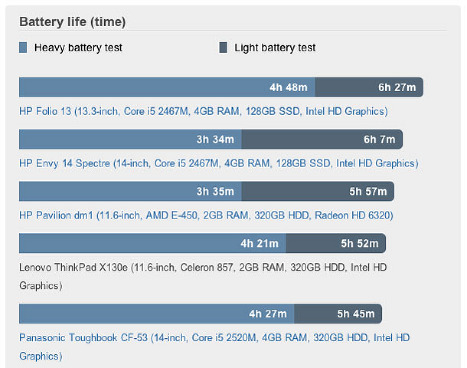Looking for a laptop that can run for most of the day without a recharge?
The boffins at technology site CNET Australia reckon that HP‘s Folio 13 Ultrabook should be top of your list, as it gallops along for almost six and a half hours on a single tank of juice.
Two more HP laptops follow the Folio – the Envy Spectre 14 and the Pavilion dm1 – before the field widens to include models from Lenovo, Dell, Asus and Toshiba.
Apple’s MacBook Air makes a surprisingly late appearance in the field, with the 13 inch model in twelfth place based on a battery life of 4 hours 43 minutes.
CNET’s aptly-named Laptops with long battery life 2012 report assesses the battery life of each notebook reviewed by the site using a pair of real-world tests.
The heavy-duty test sees the laptop playing a HD video with both screen brightness and volume wound up to full. A light HP nc6000 notebook battery test trims the screen brightness to 40 per cent and visits three different websites every 20 seconds.
CNET Australia reviews editor Craig Simms says this snapshot of the current market will be continuously updated as new laptops are released.
It can be difficult to trust a laptop maker’s own figures on battery life because “things will change depending on usage patterns” as well as how the manufacturer chooses to measure battery life, says Simms.
“Some will quote incredibly light-use battery benchmarks with most things turned off and the screen set to the lowest brightness — a totally unrealistic use scenario” he tells Australian Business Traveller. “Others, such as Samsung, tend to be more honest with their Dell Inspiron n5010 battery life estimates, using video playback stats instead.”
And while Ultrabooks are helping to set new benchmarks for battery life, Simms says he would be disappointed “if a 13 inch ultrabook didn’t hit at least four and a half hours of light use with screen brightness around 40%. The better ones can exceed six hours.”
A raft of advances in laptop technology is also helping drive battery life towards true all-day capability.
“Since the MacBook Air, quite a few laptops have (adopted) non-user removable batteries, allowing for custom shapes that allow the manufacturer to maximise battery storage for their specific laptop” Simms explains.
“Intel’s ultra-low voltage processors have made quite an impact on power draw, and yet only sacrifice minimally on performance, while on more powerful laptops, graphics switching technology that allows AMD and Nvidia graphics to switch to less power-hungry Intel graphics when the more powerful cards aren’t needed helps the laptop to save on Dell inspiron e1505 battery.”
Simms also sees the widespread use of LED back lighting in displays, “automatically dimming the screen after a period of disuse and smart dimming of screens in different light situations” as helping extend battery life.
Other Ultrabook-type trends such as dropping CD/DVD drives and replacing spinning mechanical hard disks with solid-state drives have also done their part to eke out more hours between recharges.





1 thought on “Australia’s top 5 laptops based on battery life”
Comments are closed.